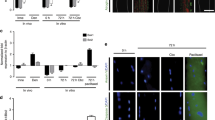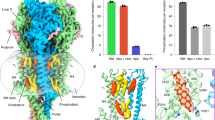Abstract
WE describe a new approach for distinguishing denervated from normal skeletal muscle fibres, based on the visualisation of differences in distribution of acetylcholine (ACh) receptors in the sarcolemma. Iontophoretic application of ACh1,2 and autoradiography with labelled α-bungarotoxin (αBuTX)3,4 have shown that after denervation (and before innervation5) ACh receptors appear throughout the sarcolemmal membrane, in contrast to their normal location in the neuromuscular junction. Using an immunopeiroxidase staining technique6,7 to localise αBuTX, which binds specifically to ACh receptors3,4,8, we now have a rapid and convenient method for high resolution, at light and electron microscopic levels, of the ACh receptors present throughout the sarcolemmal membrane of defectively innervated human and rat skeletal muscle fibres. We have used this immunoperoxidase method of molecular probing to analyse muscle biopsies in various human neuromuscular diseases and animal models.
This is a preview of subscription content, access via your institution
Access options
Subscribe to this journal
Receive 51 print issues and online access
$199.00 per year
only $3.90 per issue
Buy this article
- Purchase on Springer Link
- Instant access to full article PDF
Prices may be subject to local taxes which are calculated during checkout
Similar content being viewed by others
References
Axelsson, J., and Thesleff, S., J. Physiol., Lond., 147, 178–193 (1959).
Miledi, R., J. Physiol., Lond., 151, 1–23 (1960).
Lee, C. Y., Tseng, L. F., Chiu, T. H., Nature, 215, 1177–1178 (1967).
Hartzell, H. C., and Fambrough, D. M., J. gen. Physiol., 60 248–262 (1972).
Diamond, J., and Miledi, R., J. Physiol., Lond., 162, 393–408 (1962).
Daniels, M. P., and Vogel, Z., J. Cell Biol., 63, 76a (1974).
Daniels, M. P., and Vogel, Z., Nature (1975).
Cheng, C. C., and Lee, C. Y., Archs int. Pharmacodyn. Ther., 144, 241–257 (1963).
McLean, J. W., and NaKane, P. K., J. Histochem. Cytochem., 22, 1077–1083 (1974).
Graham, R. C., Jr, and Karnovsky, M. J., J. Histochem. Cytochem., 14, 291–302 (1966).
Fertuck, H. C., and Salpeter, M. M., Proc. natn. Acad Sci. U.S.A., 71, 1376–1378 (1974).
Koelle, G. B., in Handbuch der Experimentallen Pharmakologie, 263 (Springer, Berlin, 1963).
Standaert, F. G., and Riker, W. F., Ann. N.Y. Acad. Sci., 144, 517–533 (1967).
Katz, B., and Miledi, R., J. Physiol., Lond., 170, 379–387 (1964).
Pellegrino, C., and Franzini, C., J. Cell Biol., 17, 327–349 (1963).
Engel, W. K., and Warmolts, J. R., in New Developments in Electromyography and Clinical Neurophysiology (edit. by Desmedt, J. E.), 141 (Karger, Basel, 1973).
Author information
Authors and Affiliations
Rights and permissions
About this article
Cite this article
RINGEL, S., BENDER, A., FESTOFF, B. et al. Ultrastructural demonstration and analytical application of extrajunctional receptors of denervated human and rat skeletal muscle fibres. Nature 255, 730–731 (1975). https://doi.org/10.1038/255730a0
Received:
Accepted:
Issue Date:
DOI: https://doi.org/10.1038/255730a0
This article is cited by
-
A light microscopic study of denervation atrophy in serial sections
Experientia (1982)
Comments
By submitting a comment you agree to abide by our Terms and Community Guidelines. If you find something abusive or that does not comply with our terms or guidelines please flag it as inappropriate.



